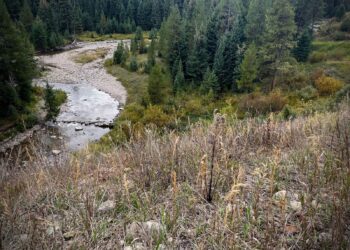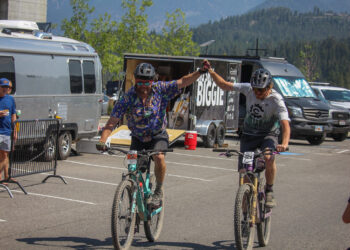Advice for endurance athletes
By Eric Anderson, M.D.
Last summer, while I was visiting a friend in Colorado, I had a conversation with his mother Cheryl that changed the way she looked at sports nutrition.
A very active recreational athlete in her 50s, Cheryl struggles with excessive thirst and fatigue, despite regular consumption of water and calories during activity. She also gets muscle cramps on hot days while riding her bike.
When Cheryl showed me a basket in her pantry containing electrolyte tablets, carbohydrate and protein bars, powders and gels, I realized her sports nutrition issues weren’t related to a lack of sports nutrition products. Rather, they were due to a relative imbalance of salt, sugar and water during endurance activities greater than an hour.
Before going for a hike that day, Cheryl and I talked details and designed a new plan for her sports nutrition.
For carbohydrate replacement during workouts, Cheryl prefers using a solid form form of what? as opposed to sports drinks or gels. Using the product’s nutrition label, we calculated how much she would have to consume to ingest the necessary amount of carbohydrates (30–60mg) per hour.
For electrolyte replacement, she likes to add tablets to her two-liter hydration backpack. I recommended she use three tablets, equating to about 1000mg of sodium, and drink at least .5 liters per hour. She also had some additional sodium in her carbohydrate source.
On our 10-mile hike, we climbed to 10,000 feet, and the temps reached the high 80s. Cheryl reported results already: she had improved energy, decreased thirst, and no problems with cramping compared to previous endurance activities during the summer.
When doing an endurance activity greater than an hour, consider the basic concepts of salt, sugar and water to optimize performance and minimize the risk of dehydration or hyponatremia (see below). Be fastidious about reading the nutrition labels of all of your sports nutrition products to determine if they will fit into your overall sports nutrition/hydration plan.
Also, estimating your sweat losses by taking pre- and post-exercise body weights for each endurance activity in different climates will help you gain an understating of your physiology and personalize a fluid replacement plan. Since fluid losses vary tremendously between individuals, the American College of Sports Medicine recommends each person should approximate his or her fluid replacement requirements by comparing post-exercise weights to pre-exercise weights and estimating fluid losses during the activity. Use nude weight to avoid determining the sweat weight trapped in clothing.
The math
Specifically, the product Cheryl uses has about 30 grams of carbohydrate per serving and there are two servings per package, according to the nutrition label. Dr. Anderson recommended she consume about one package per hour, since it would be her only carbohydrate source during her workout. Alternatively, she could have chosen to use a sports drink, such as Gatorade, which has 14 grams of carbohydrate per eight ounces. If she were consuming 16 ounces per hour of Gatorade, she only would have to consume half of a package of her product per hour to maximize her carbohydrate intake.
Exercise physiology basics
Exercise requires metabolic energy and produces heat as a byproduct. This heat production can increase surface and core body temperatures and must be dissipated to prevent adverse effects on exercise performance and health.
Heat dissipation can occur through a variety of mechanisms; sweat evaporation is the primary mode of heat loss during vigorous activities, especially in hot weather. Sweat rates vary, even under the same environmental and exercise conditions; an individual’s body weight, genetic predisposition, heat acclimatization state and metabolic efficiency all affect his or her tendency to sweat.
Sweat rates vary between sports, from .37 liters per hour swimming up to 2.6 liters per hour for tennis players in a hot environment. Cyclists and runners average sweat loss is about .8 liters per hour and 1 liter per hour respectively in a temperate climate. These values can easily double in a hot environment.
Sweat contains both water and electrolytes. The electrolyte components of sweat include sodium, chloride, potassium, calcium and magnesium, with sodium and chloride in higher concentrations than the others. The relative electrolyte concentrations don’t vary based on sex, maturation or aging. Sodium chloride, or salt, is partially reabsorbed by sweat glands; however, the body’s capacity to reabsorb salt doesn’t increase as the sweat rate increases. If sweat, water and electrolyte losses are not replaced during exercises, an individual will become dehydrated.
Salt
Sodium is involved in a variety of metabolic processes in the human body and is the main electrolyte responsible for maintaining the body’s fluid balance.
The human body is not capable of losing salt without also losing water.
Sodium loss during exercise is highly variable, ranging from 460-1840 mg/L of sweat hourly.
Individuals in certain sports can sustain sweat losses of over two liters per hour, which equates to over 1000mg of sodium lost. Therefore, if sodium replacement is not part of your nutrition plan during exercise, you significantly increase your risk of dehydration.
Dehydration can lead to impaired exercise performance, increased risk of heat illness such as heat stroke, and increased susceptibility to cramping.
The American College of Sports Medicine recommends that during sustained activities lasting more than an hour, individuals should consume about 500-700mg of sodium for every liter of fluid. However, there is tremendous variability in these numbers, depending on a variety of factors.
Generally, the more sustained the exercise and the hotter the environment, the more salt you need to intake. If you’re prone to cramping in hot weather, upwards of 500-700mg of sodium per liter of fluid is recommended.
When I compete in a cycling road race that lasts longer than three hours on a hot day, my goal is to consume around1000mg of salt per hour. To do this, I combine a sports drink like Gatorade endurance, which has 170mg of sodium per 8 ounces (680mg per 32 ounces) with and a carbohydrate/electrolyte containing gel such as power gel or GU. I usually use power gels since they contain about 200mg of sodium per gel package. Therefore, if I am consuming about 32 ounces per hour along with 1 gel per hour I will be consuming about 880mg of salt per hour.
A less common but more serious problem is exercise-associated hyponatremia (low blood plasma concentration of sodium). This is mostly seen in recreational marathon runners who consume copious amounts of hypotonic (low sodium) fluids during sustained exercise. In this case, a person’s fluid consumption far exceeds his or her sweat loss. The result is a low plasma sodium concentration that can increase the risk for brain swelling, seizures, coma and death.
Sugar
During exercise, the body’s main source of fuel is a stored form of glucose (sugar), found in skeletal muscle and the liver called glycogen. The human body has enough glycogen to sustain exercise at a moderate intensity for about two hours.
Research has shown that consumption of rapidly absorbable carbohydrates such as glucose, sucrose and maltodextrins significantly improves performance during exercise lasting longer than 45 minutes.
Carbohydrates consumed with fluids improve performance to a greater degree than consuming them alone. But the human body has a capacity limit for absorbing carbohydrates during sustained exercise, and excessive intake can lead to gastrointestinal issues like stomach cramps, nausea and diarrhea.
Consuming 30-60 grams of a rapidly absorbable carbohydrate during each hour of exercise should optimize performance and minimize the potential for gastrointestinal side effects.
An athlete can have the same benefit from consuming a gel pack and water as from a sports drink alone because the form of the carbohydrate (solid or liquid) doesn’t affect exercise performance.
Water
Water accounts for 45-75 percent of a human’s total body mass. A 150-pound person has about 42 liters of total body water (TBW), which equals about 92 pounds of body weight.
Dehydration of greater than 2 percent of TBW decreases aerobic exercise performance and cognitive and mental performance in temperate and hot environments. This equates to water loss of about .8 liters in a 150-pound person.
One liter of water weighs about 2.2 pounds.
Pre-exercise weight: 150 pounds
Post exercise weight: 145 pounds
150-145 = 5 pounds of weight loss during exercise
Five pounds/2.2 pounds per liter = approximately 2.3 liters of water lost during exercise
This calculation doesn’t take into account respiratory water losses and carbon exchange during exercise; however, it allows for a reasonable approximation of a person’s sweat losses.
A suggested starting point for fluid replacement for a prolonged endurance event is drinking .4-.8 liters per hour, with higher rates for warmer environments and lower rates for cooler environments.
Dr. Eric Anderson works in sports medicine at the Rockwood Clinic in Spokane, Washington.
Reference:
Sawka, Michael N., et al. American College of Sports Medicine Position Stand on Exercise and Fluid Replacement. Medicine and Science in Sports and Exercise. 39:377-390, 2007.













